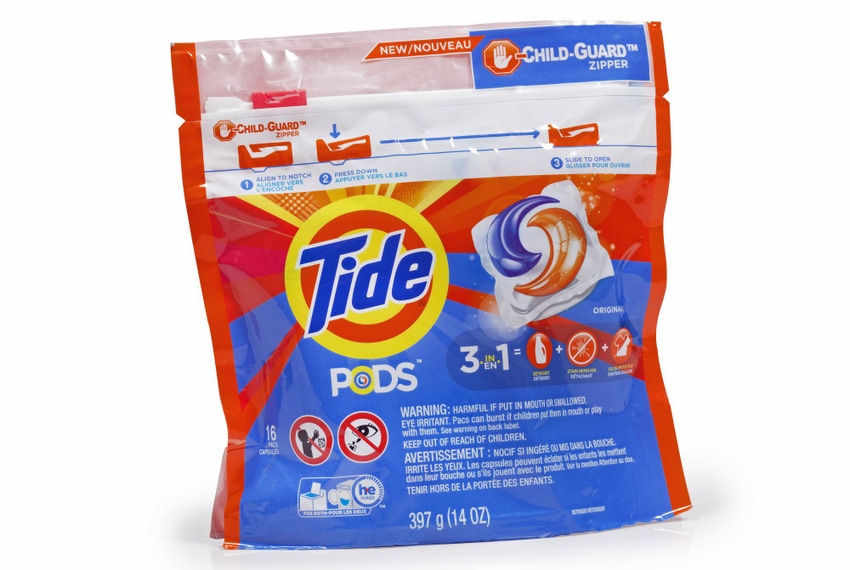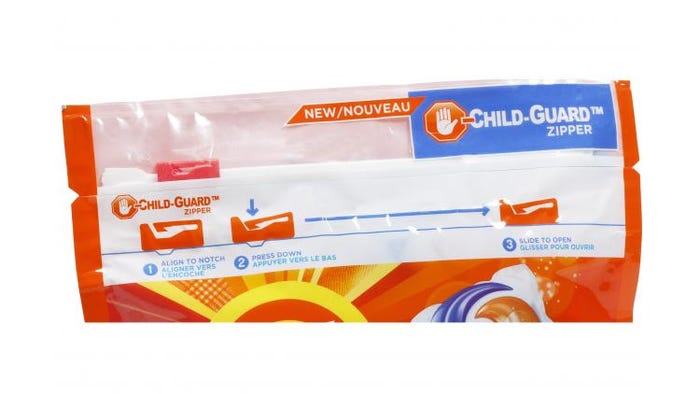Product-in-package safety is shared responsibly
May 16, 2016

Gary Kestenbaum explores some practical, value-added steps for packaging professionals to consider when home use of marketplace packaged products results in hazards to human health and safety.
Recently, the national television news media aired a story focusing on the steady increase in occurrences of child poisonings from ingestion of eye-catching, attractive products intended for adult or household use. Examples included medications, e-cigarette liquid nicotine, laundry and dishwasher detergent single use packets, and, to a lesser degree, medical marijuana edibles and alcohol beverages.
Post investigation information links typical child attraction to availability, curiosity, visual attributes (such as product color, geometry or feel) and a misinterpretation of harmful products that appear toy or candy-like. Case narratives were disturbing due to both recognition that the victims were unsuspecting children and the alarming levels of annual incident increase.
The statistics suggest that consumer product development and marketing teams need to focus on early-on Design Hazard and Safety Risk Analysis (DHSRA). Packaging professionals, designers and converters represent functions that turn functional, affordable primary and secondary packaging into unique, tantalizing, eye-catching products with shelf presence intended to drive purchase intent and brand recognition.
In advance of cutting-edge marketing plans and record-breaking sales numbers that entice the “Development Team” to quickly get to market, the product toxicology and safety functions need to add comprehensive product and package risk assessments into the timeline, giving product and packaging developers and their partners time to understand and mitigate product hazards.
Design hazard and safety risk analysis
DHSRA has long been used as a valuable tool by many industries to brainstorm and predict iterative product misuse, abuse and outright danger before commercialization and sale. In situations where safety hazards increase or risk profiles change once products are in market, a post-commercialization DHSRA is warranted.
Household consumer products and pharma manufacturers have performed lengthy studies on the subject of inadvertent access by and harm to children and have responded with improvements intended to control access and risk. A sensible approach to a DHSRA is to investigate and become familiar with known risks and related solutions associated with product and package hazards. Basic examples include use of child-resistant primary packaging, integrated for many years into medications and household products. However, as product forms, usage patterns and child sophistication changes, existing or time-honored solutions may no longer represent effective protection. New ideas or rewired solutions will likely be needed to more effectively control child hazard risks.
In advance of performing a Design Hazard and Safety Risk Analysis, I offer the following suggestions:
• Build in time to properly perform DHSRA. Base that on multiple factors, including the complexity of the assignment and guidance from the project manager.
•Retain an experienced consulting firm with broad knowledge in process, leadership, execution, analysis and related skills. “Process” experience is more valuable than specific product expertise.
•Inform the key project and supply chain partners of the marketing, use and design objectives and integrate them into the ideation/discussion processes. Create and present an executive summary to key players in the process, making sure that non-disclosure agreements and intellectual property ownership documents are completed as per company guidelines. When time is of the essence, supplier technical experts often add practicality and effectiveness not considered outside of their expert disciplines.
•Complete the client questionnaire with as much information as possible. DHSRA clients are best served when providing the project manager with comprehensive details on product formulation and toxicity, packaging geometry, materials, typical consumer demographics, usage patterns and expectations.
Built-in challenges
As the process evolves, involved functions (project manager, product developer, packaging engineer, toxicologist and others) will be challenged to discuss, consider and address potential risks or hazards and assess practical mitigations. The very nature of marketing is to make a product appealing to the purchaser. Marketers of products that might fall into “little hands” face the challenge of creating a product that is appealing to the purchaser/user, yet disinteresting and inaccessible to young children.
A DHSRA targeted to non-comestibles—such as detergent pods or adult-oriented comestibles, for instance, marijuana-containing candy or alcoholic beverages—should include the product and the packaging. Bright colors and tempting visual attributes are sure to attract children who might reasonably mistake the item for a familiar edible or toy. Intriguing tactile features or child-familiar graphics may evoke a similar response.
Challenges to consider may include:
• How to formulate the product and/or packaging to function as intended using non-toxic or reduced toxicity components.
•How to create a balance between pleasing, identifiable colors and graphics that drive purchase intent and increased customer use versus the risks associated with pleasing, identifiable colors and graphics attractive to children that may increase misuse potential.
• The use of icons or child-recognizable warnings or symbology.
• Design that optimizes ease of use and performance, yet considers shape and tactile feel of a primary package attractive to children.
• Assessing the practicality and effectiveness of child-resistant overwraps or containers for single-dose packets.
• Assessing the value and effectiveness of providing target consumers with secondary packaging (possibly reusable) designed with a child-resistant accessibility.
• The costs and timing barriers created by the need to produce and test multiple product iterations to find one that satisfies both business and safety objectives.
• Reluctantly taking a “no go” option when the risk/reward ratio is so disproportionate that the specter of litigation, regulatory intervention, redesign, market withdrawal or negative publicity are at a risk of outweighing the benefits of a launch.

Execution and accomplishment
Pharmaceutical and over-the-counter medication manufacturers have reduced child misuse through continuous improvements in restrictive packaging design and technology.
Similarly, a major household consumer products company, P&G, has been applying continuous safety improvements to its premeasured Tide brand detergent pods with the intent to respond to and reverse the alarming increase in documented cases of harm to children.
Based on subject-related public information supplied by this manufacturer, the company appears to have combined product and package R&D skills with business development teams and external resources in its objective to inhibit child access and misuse without compromising product benefits to the targeted users.
Prior to 2016, P&G added a taste deterrent component to the exterior of the primary package, redesigned the composition and/or basis weight of the film to delay release of the inner components and increased burst strength of the single-use pack with the objective of improving small child squeeze-pressure resistance. It also redesigned a more secure rigid secondary package closure and reduced visibility of the pack within the “sell unit." These changes were consistent with guidance provided by the ASTM in response to previously described increases in child-related incidents.
This year, P&G commercialized another improvement, a redesign and relaunch of its flexible pouch multipack option. The former version of this option appeared to be a standup flexible pouch, with reclose, containing multiple packets. The company collaborated with packaging vendors and converters to develop and apply a redesigned “zipper” that functions as a robust child-resistant reseal, engineered to resist initiation and propagation by a young child even after demonstration of the opening process.
P&G solves the challenge of appealing to consumers with variable risk levels by providing an added safety child-resistant multipack option in addition to the original rigid multipack with standard reclose, giving purchasers the ability to benefit from product convenience and the choice of access control features.
Naturally, the best protection against childhood misuse is a consistent lock and key approach with effective parental guidance and control, or the “no-buy” solution wherein parents just don’t purchase harmful items that “the kids will get into.” The more practical approach for consumer product marketers is to design a product that does not add unnecessary risk, but conversely reduces risk and adds levels of control or discouragement. Process effectiveness is enhanced following performance of a collaborative DHSRA, fully supported and properly resourced by the organization, executed by cross-functional stakeholders and coordinated by an expert project manager.
Gary Kestenbaum has 40 years’ experience in the food and packaging industries, 6 as a supplier with National Starch, 18 as a product developer with General/Kraft Foods and 15 as a packaging engineer and developer with Kraft. As senior food packaging safety consultant with EHA Consulting Group, Kestenbaum provides guidance on packaging safety and suitability-related projects for raw material manufacturers, converters and associated supporting professionals. He can be reached at [email protected] or 410-484-9133. The website is www.ehagroup.com.
About the Author(s)
You May Also Like




